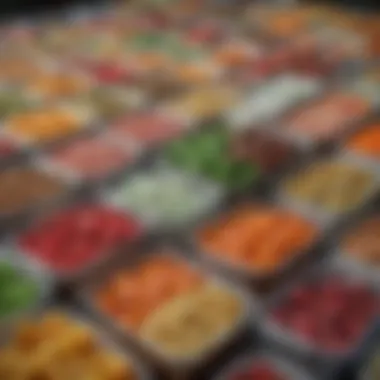Thermal Food Containers: Your Essential Guide


Intro
Thermal food containers are increasingly becoming essential in our everyday lives, especially for those who value convenience and sustainability. These containers play a pivotal role in maintaining the temperature of food, whether hot or cold, during transportation or storage. Understanding the dynamics of thermal insulation provides a clearer picture of their significance in food preservation and safety. This guide aims to dissect various aspects of thermal food containers, covering their functionality, the materials used, and their design features. By delving into this topic, we can uncover the ways in which these containers serve culinary enthusiasts and health-conscious individuals alike.
Recipe Overview
While the guide will not present a traditional recipe per se, we can think of thermal food containers as the "ingredients" essential for preserving culinary creations. The containers you select can influence your entire dining experience, much like the choice of flavors in a dish. Each design and material offers unique benefits tailored to different needs and preferences.
Materials and Designs
Thermal food containers come in a variety of materials, each with its own characteristics:
- Stainless Steel: Known for its durability and resistance to rust and corrosion. It tends to retain heat efficiently.
- Plastic: Lightweight and often more affordable. However, less effective at keeping food hot or cold for extended periods. Always check for BPA-free labels to ensure safety.
- Glass: Offers excellent insulation and can be microwave-friendly. However, glass can be heavier and more prone to breakage.
The design of a thermal food container also plays an intricate role. Insulated lids and vacuum seals can significantly enhance performance. Selecting containers with proper seals is crucial for ensuring that heat or cold is maintained while reducing the risk of spills.
Functionality and Benefits
The fundamental role of thermal food containers lies in their ability to preserve food temperature. In many cases, proper insulation can keep hot food hot for several hours, while cold food can remain chilled for an extended period. This functionality is particularly important for:
- Meal Prepping: For those who prepare meals in advance, these containers help to maintain the integrity of flavors and nutrients.
- Picnics and Travel: When traveling, having access to meals at the desired temperatures can enhance the experience significantly.
- Food Safety: Keeping food at the right temperature is vital in preventing foodborne illnesses; thermal containers assist in doing so.
"Choosing the right thermal food container can greatly enhance your culinary experience, ensuring both safety and satisfaction in meals served fresh and hot or refreshing and cold."
Environmental Considerations
As consumers become more environmentally conscious, it is essential to consider the ecological footprint of thermal food containers. Materials such as stainless steel and glass are often seen as more sustainable options compared to single-use plastic. By selecting durable, reusable containers, we not only maintain food quality but also contribute to reducing waste. The lifecycle of these containers, from production to disposal, impacts our environment significantly.
Market Offerings
The market is flooded with a diverse range of thermal food containers. Brands like Thermos and Zojirushi offer high-quality options that cater to various needs. Whether looking for containers to keep soup hot or salads cold, consumers can find products tailored to specific preferences, materials, and designs. Reading reviews and understanding features before purchasing can ensure a wise investment in products that serve their intended purpose effectively.
Culmination
Choosing the right thermal food container is more than just an accessory in the culinary scene. It is about improving food storage and transportation. By considering functionality, materials, design, and environmental impact, one can enhance culinary experiences while ensuring food safety. This guide serves as a starting point for anyone looking to make informed decisions about thermal food containers. Engaging with these tools allows individuals to enjoy their meals precisely as intended, whether at home, at a picnic, or on the go.
Understanding Thermal Food Containers
Thermal food containers present a fascinating intersection of practicality and science. In the realm of food transport, these vessels are designed to maintain optimal food temperatures, whether hot or cold. This functionality is paramount for several reasons. Firstly, it ensures that food safety standards are met. Consuming food that has been held at improper temperatures can result in foodborne illness. Secondly, they enhance the culinary experience, providing convenience for enthusiasts who appreciate enjoying meals at their peak freshness.
The development and understanding of thermal containers encompass various important elements including their insulation technologies, material choices, and usability designs. Recognizing these aspects can significantly impact one’s selection process when choosing the right thermal food container. Furthermore, being aware of their historical evolution sheds light on the advancements made in this field, showcasing how these containers have improved over time to accommodate evolving consumer needs.
Definition and Purpose
Thermal food containers are specialized vessels designed to preserve the temperature of food. They accomplish this through an insulation method that minimizes heat transfer. The primary purpose of these containers is to ensure food remains at a safe temperature during transport, mitigating risks associated with food spoilage. This is particularly essential for meals that require specific storage conditions, like hot soups or chilled salads. In essence, they are integral for meal prep, picnics, or any scenario where food needs to be transported.
Several types of thermal food containers exist, each designed for specific meal types and contexts. For instance, vacuum insulated containers often feature double-walled construction, which provides exceptional thermal retention. Meanwhile, thermal lunch boxes are typically designed for portion control and may incorporate multiple levels for various food items.
Historical Development
The journey of thermal food containers traces back to early innovations in insulation. Initial attempts included basic materials that provided minimal heat retention. However, as the understanding of thermodynamics evolved, so did the design and functionality of these containers. The advent of vacuum insulation technology in the 20th century was a game-changer. By removing air between two walls of the container, this method dramatically improved heat retention capabilities.
Over the decades, manufacturers have adapted to consumer preferences, resulting in a diverse range of products that emphasize both functionality and aesthetics. From stainless steel flasks to brightly colored lunchboxes, today's thermal food containers offer far more than just temperature control. They cater to lifestyle trends and sustainability, appealing to a broad audience that values both utility and design.
Key Features of Thermal Containers
Understanding the key features of thermal food containers is essential for anyone interested in food preservation and transport. These features not only enhance the utility of the containers but also ensure that food remains safe and at optimal temperature during transit. Evaluating these elements can significantly aid consumers in making informed choices that align with their specific needs.
Insulation Technology
Insulation technology is the backbone of any thermal food container. It plays a critical role in maintaining the desired temperature of the food inside. Two main technologies dominate this sector: vacuum insulation and foam insulation. Vacuum insulation consists of two walls with a vacuum between them, preventing heat transfer. This design can keep beverages hot for several hours or cold for an extended period. On the other hand, foam insulation utilizes a foam layer that slows down temperature exchange. This technology is typically found in more affordable options and offers decent performance but may not match the efficiency of vacuum insulation. The choice between the two often depends on personal needs and preferences.


Material Considerations
When it comes to thermal food containers, the materials used are crucial to both performance and safety. Stainless steel and plastic are the most common materials. Stainless steel is favored for its durability and ability to resist odors and stains. It also does not leach chemicals into food, making it a safer choice. Conversely, some containers utilize BPA-free plastic, which offers lightweight options and affordability. However, concerns regarding long-term exposure to heat and potential chemical leaching raise questions about its safety. Moreover, it's vital to consider the thickness of the walls, as thicker materials usually provide better insulation but add weight.
Design and Usability
The design of thermal food containers impacts their usability significantly. Features such as size, shape, and handle design are essential aspects to consider. Many modern containers come in various sizes to accommodate different meal portions, making them versatile for various users, from kids to adults. Additionally, a wide mouth or spout design can ease pouring or scooping, enhancing the overall user experience. Locking lids and thermal seals are also vital to prevent spills and maintain insulation. Moreover, lightweight designs and easy-to-carry handles increase portability, making it easier to transport meals for work, school, or trips.
A good thermal container blends functionality with aesthetics, ensuring both the food’s safety and user satisfaction.
In summary, the key features of thermal food containers—the insulation technology, material considerations, and design and usability—are paramount in their effectiveness and practicality. Understanding these elements can lead to better choices and enhanced overall satisfaction for those looking to preserve their meals.
Types of Thermal Food Containers
Understanding the various types of thermal food containers is pivotal for anyone serious about food preservation and transportation. Each type serves unique purposes and offers particular benefits. The right choice can enhance meal quality, ensure safety, and improve overall user experience. Let us explore the various categories in detail.
Vacuum Insulated Containers
Vacuum insulated containers are among the most effective choices for keeping food hot or cold for extended periods. These containers utilize two walls with a vacuum in between. This design minimizes heat transfer, effectively maintaining the desired temperature of the contents. When selecting a vacuum insulated container, consider the size and material. Stainless steel models are durable and resistant to rust, making them popular.
Benefits of vacuum insulated containers include:
- Extended temperature retention: Foods or drinks can remain hot or cold for hours.
- Durability: Built to withstand daily use without damage.
- No condensation: A vacuum seal prevents moisture from forming outside, which is a plus for packed lunches.
Thermal Lunch Boxes
Thermal lunch boxes are designed primarily for transporting meals. These containers often have multiple compartments, allowing users to pack various foods without mixing. Their insulation technology works to maintain the ideal temperature until lunchtime. It is important to assess the insulation quality and ease of cleaning when considering a thermal lunch box.
Key points to note about thermal lunch boxes:
- Portability: Designed for easy transportation, they fit well in bags or backpacks.
- Versatility: Suitable for a range of foods from salads to warm dishes.
- User-friendly: Most models offer features like easy-open lids and dishwasher-safe materials.
Thermal Flasks
Thermal flasks primarily cater to hot or cold beverages. Often used for coffee, tea, and soups, they are engineered for outstanding insulation. Materials usually include stainless steel or glass. When looking for a thermal flask, focus on the lid design as it greatly affects usability.
Considerations for thermal flasks include:
- Capacity: Available in various sizes to meet individual needs.
- Ease of use: A wide opening makes pouring simple and efficient.
- Leak-proof design: Essential for travel to avoid spills.
Multifunctional Containers
Multifunctional containers combine features from several types, offering flexibility for different culinary needs. They often come with separate compartments allowing for the organization of various food types and textures. These containers are ideal for people who enjoy meal prepping or need different food options on the go.
Advantages of multifunctional containers are:
- Cost-effectiveness: One container can serve multiple purposes, minimizing kitchen clutter.
- Convenience: Easily switch between storing food, serving, and reheating.
- Smart design: Often compact and easy to store when not in use.
The choice of container can greatly influence your meal's temperature, safety, and quality. Choosing the right one is not just about function; it also considers lifestyle and preferences.
Benefits of Using Thermal Food Containers
Thermal food containers serve multiple purposes that greatly enhance the experience of food storage and transportation. They are not only a practical solution for keeping food hot or cold; they also offer significant advantages in terms of food preservation, temperature control, and convenience. Understanding these benefits is essential for those considering the purchase of thermal food containers, particularly for food lovers who appreciate quality and safety in their meals.
Food Preservation
The primary function of thermal food containers is to preserve food freshness and quality for a longer period. These containers are designed to create a barrier between the food and external temperatures, thereby minimizing exposure to environmental factors that can lead to spoilage. For instance, vacuum insulated containers significantly slow down the warming process which helps to maintain the original flavor and texture of the food.
Consistent temperature helps protect delicate items like salads and creamy dishes, which may spoil quickly when subjected to fluctuating heat. Furthermore, many thermal containers feature materials that prevent the growth of bacteria, which is critical for food safety. Hence, thermal food containers not only keep food warm or cold but also maintain its nutritional value and taste.
"Proper food preservation in thermal containers enhances not only safety but also the overall culinary experience."
Temperature Control


Temperature control is a key aspect of thermal food containers. They excel at maintaining a specific temperature, whether hot or cold, for extended periods. This capability is especially important for individuals who travel or do not have immediate access to heating or refrigeration. For example, people who work long hours or enjoy outdoor activities can rely on thermal flasks to keep their beverages hot or cold throughout the day.
Many thermal containers come with a stated retention time, indicating how long they can maintain their contents at a desired temperature. When selecting one, consider the intended use and how long you expect to keep the food at a safe temperature. This informs the choice of container and ensures optimal enjoyment of meals regardless of location.
Convenience and Portability
The convenience offered by thermal food containers cannot be overstated. Their lightweight and compact designs make them ideal for busy lifestyles. The portability of these containers ensures that food can be enjoyed anywhere, from office lunches to picnics in the park. Some models even feature compartments and multiple tiers that allow users to store diverse types of food separately, which further enhances usability.
Moreover, many thermal food containers are durable and designed to withstand everyday wear and tear. This durability means they are ideal for not only personal use but also for family outings or group gatherings. As a result, individuals and families alike can adopt a more versatile and organized approach to meal preparation and consumption.
In summary, thermal food containers provide essential benefits that cater to food lovers' varied needs. From preserving food effectively through improved temperature control to offering unmatched convenience and portability, these containers are indispensable tools for anyone who values quality meals on-the-go.
Environmental Impact of Thermal Food Containers
The relevance of environmental impact in the context of thermal food containers cannot be overstated. As consumers become increasingly aware of environmental issues, the focus on how everyday products affect our planet has intensified. This section will discuss the specific elements of material sustainability and the importance of reusability and recycling. These factors significantly influence consumer choices and the long-term viability of thermal food containers in an eco-conscious world.
Material Sustainability
Material sustainability in thermal food containers revolves around selecting materials that minimize environmental harm. Common materials used in these containers include stainless steel, glass, and certain plastics. Each material has its own set of advantages and drawbacks from an ecological perspective.
Stainless Steel is favored for its durability and recyclability. It does not leach harmful chemicals, which is beneficial for food safety. Additionally, stainless steel containers can last for years with proper care. Thus, they reduce the need for frequent replacements. However, the energy consumption involved in the production of stainless steel can be high, necessitating careful consideration of the container's lifecycle.
Glass containers are also a sustainable choice. Glass is entirely recyclable, and unlike plastics, it does not leach toxins into food. However, it is heavier and more fragile, which can complicate portability. Therefore, while glass offers superior food safety, its physical properties can limit its practicality in some cases.
Plastics are often seen as less sustainable due to their potential environmental harm. Many thermal food containers use BPA-free or recycled plastics to mitigate some concerns, but the status of plastics in a sustainable context remains contentious. They take hundreds of years to decompose and contribute to landfill issues. Thus, it is vital for consumers to choose products that promote sustainability in their material choices.
Reusability and Recycling
Reusability and recycling are crucial aspects of reducing environmental impact. Thermal food containers that are designed for multiple uses significantly lower the amount of waste generated. By using containers repeatedly instead of disposable options, consumers contribute to reducing their carbon footprint and limit their reliance on single-use products.
Recycling processes are essential, particularly for metals and glass. Consumers should consider how easily a thermal food container can be recycled at the end of its life cycle. While many manufacturers indicate recyclability on packaging, it is also important for consumers to be aware of local recycling regulations. Here are some points to consider:
- Recycling Rates: Not all containers are recycled at the same rates. For instance, aluminum and glass often have higher recycling rates than plastic.
- Facility Availability: Some thermal containers might not be accepted by local recycling centers. Checking local guidelines ensures proper disposal.
- Design for Disassembly: Advanced designs that allow easy separation of components promote better recycling outcomes.
In summary, the selection of materials, emphasis on reusability, and focus on recycling efforts are vital for reducing the environmental impact of thermal food containers. By understanding these factors, consumers can make informed choices that align with their values and promote a more sustainable lifestyle.
Ensuring that thermal food containers are environmentally friendly should not only be a consideration during the selection process but also guide how they are maintained and repurposed throughout their lifespan.
Selecting the Right Thermal Food Container
Choosing the right thermal food container is crucial for anyone looking to optimize their food storage, transportation, and enjoyment. These containers play an essential role in maintaining the temperature of meals—keeping them warm or cool—while also ensuring that food remains safe for consumption. Several factors come into play when selecting a thermal container, including intended use, insulation properties, materials, design, and personal preferences. A thoughtful decision can enhance your culinary experiences, whether packing a lunch for work, keeping food warm during travels, or enjoying a picnic.
Assessing Your Needs
Understanding the specific needs is the first step in selecting the right thermal food container. Think about how you plan to use the container. Are you looking for something to keep soups warm during a winter outing? Or do you need a leak-proof option for salads and dressings? Make a list of your common scenarios. You should consider the following:
- Intended Use: Different containers suit different purposes. For instance, vacuum insulated containers excel in maintaining temperatures for hot liquids, while thermal lunch boxes might cater well for a full meal.
- Capacity: Depending on your meal size or portion size, you should determine the capacity needed. Go for containers that match the amount of food you usually carry.
- Frequency of Use: If you plan to use the container daily, opt for something durable. On the other hand, occasional use might allow for lighter options.
- Portability: If you are frequently on the go, consider weight, shape, and handles for easier carrying.
Evaluating Features and Specifications
Once you have a clear idea of your needs, examine the container's features and specifications. Here are key aspects to consider:
- Insulation Performance: Look for containers that provide effective insulation, usually reflected in their temperature retention duration. Higher performance means better insulation materials used, like stainless steel or double-walled construction.
- Material Quality: The materials used in construction should be food-safe and durable. Common choices include stainless steel, plastic, and glass. Each has its pros and cons. For example, stainless steel is resistant to staining and odors, whereas glass is non-toxic and provides a clean taste.
- Ease of Cleaning: Some designs allow for easier cleaning, which can be a significant factor if you plan to use the container frequently. Features like wide openings or detachable components can make maintenance simpler.
- Lid and Sealing Mechanisms: Consider how securely the lid closes. Leaks can lead to messes, so look for containers designed with reliable seals.
Brand Comparisons
When it comes to thermal food containers, several brands offer varying quality and features. Conducting brand comparisons can help identify the best options available. Here are a few reputable brands to consider:
- Thermos: Known for its vacuum insulation technology, Thermos provides products that excel in heat retention.
- Zojirushi: This brand offers a wide range of thermal containers with innovative designs and exceptional performance, especially in keeping beverages hot.
- Contigo: Popular for their style and easy-to-use lids, Contigo containers are ideal for everyday use and portability.
- Food Flask: Focused more on functional designs, Food Flask is known for their affordable yet reliable options.
Maintenance and Care for Thermal Food Containers
Maintaining and caring for thermal food containers is essential for maximizing their lifespan, efficiency, and performance. These containers are designed to keep food at optimal temperatures, but improper handling can compromise their effectiveness. Understanding how to clean and store these items can preserve their functionality and maintain hygiene.


Cleaning Guidelines
Cleaning your thermal food containers should be done regularly, especially after each use. Here are some key guidelines to follow:
- Immediate Cleaning: Rinse your container right after you finish using it. This helps prevent food from drying and sticking inside. The longer you wait, the harder it becomes to clean.
- Gentle Cleaning Agents: Use mild soap and warm water for washing. Avoid abrasive cleaners or scour pads that may scratch the interior.
- Dishwasher Safety: Check if your container is dishwasher safe. If so, place it on the top rack only. If not, hand wash it to avoid damage.
- Deep Cleaning: For stubborn odors or stains, consider using a mixture of baking soda and vinegar. Let it sit for a few hours, then rinse thoroughly.
Regular maintenance keeps your container like new and ensures safe food storage.
Storage Tips
Proper storage of thermal food containers is equally important. To maintain their insulation properties and functionality, heed the following tips:
- Dry Before Storing: Ensure the containers are completely dry before storing them away. Moisture can lead to mold growth.
- Avoid Extreme Temperatures: Store in a cool, dry place, away from direct sunlight and high heat sources. This can help prevent material degradation.
- Stacking Containers: If you have several, make sure they are nested properly if designed for stacking, or store them upright to keep the interiors free from scratches.
- Check for Damage: Periodically inspect your containers for cracks or dents. Any damage may affect insulation and should be addressed promptly.
By following these guidelines, you can ensure that your thermal food containers remain in optimal condition for years, providing you with convenience and reliability in food storage and transport.
Market Trends in Thermal Food Containers
The market for thermal food containers has evolved significantly in recent years. This evolution mirrors changing consumer behaviors, technological advancements, and increasing environmental consciousness. Understanding these trends is vital for both manufacturers and consumers as it shapes the market landscape. Insights into these trends guide purchasing decisions and influence product development and marketing strategies.
Innovation in Designs
In the last few years, innovation in designs has become a focal point in the thermal food container industry. Manufacturers are increasingly investing in research and development to meet the diverse needs of consumers. Design innovations not only improve aesthetics but also enhance functionality. For instance, some thermal containers now feature modular designs, allowing users to customize their food storage depending on the meal type. New materials, like advanced plastics and composites, are being used that blend durability with lightweight properties.
Moreover, designs are being tailored for specific lifestyles. For instance, containers designed for outdoor enthusiasts often include features like integrated sporks or collapsible cups. In contrast, urban professionals may prefer sleek, compact designs that fit easily into briefcases. Such attention to design is key, as it influences consumer choices and brand loyalty.
"The right design can transform a simple container into a necessity; it can enhance the user experience dramatically."
Consumer Preferences
As consumer preferences shift, manufacturers must adapt to stay relevant. Today's consumers are more informed and prioritize sustainability alongside functionality and convenience. Eco-friendly materials, including recycled plastics and biodegradable options, are becoming popular choices. Consumers are scrutinizing product origins and looking for brands that align with their ethical values.
Furthermore, compact and multifunctional thermal containers are gaining traction. With busy lifestyles, consumers seek products that offer versatility. A container that can transition from a lunch box to storage for snacks, or adapt for both hot and cold foods, is often seen as more attractive.
In summary, the market trends in thermal food containers highlight a clear path toward innovation and adaptation. Understanding both the innovations in design and changing consumer preferences equips stakeholders to make informed decisions, whether in purchasing or developing new products.
Questions and Answerss about Thermal Food Containers
The section addressing frequently asked questions about thermal food containers plays a critical role in this comprehensive article. It serves to clarify misconceptions, illuminate user concerns, and provide practical advice for maximizing the use of these containers. Given the increasing awareness of food safety and sustainability, this discussion is essential for those looking to enhance their culinary experiences while preserving food integrity and minimizing environmental impact.
Common Misconceptions
Many myths circulate regarding thermal food containers. One common misconception is that all thermal containers are the same. In fact, the efficiency of a container often varies based on its material, design, and insulation technology. For instance, vacuum-insulated containers can keep food hot or cold for longer durations than standard plastic or glass containers.
Another myth is that thermal food containers are only for hot food. While they excel at maintaining high temperatures, certain types are also designed for cold dishes, such as salads or desserts. This versatility is pivotal for users who wish to transport various types of food.
Lastly, some people believe that thermal containers are difficult to clean. However, many modern containers are designed with user convenience in mind. Most are dishwasher safe or feature removable parts that make them easy to maintain. Understanding these misconceptions can aid users in making informed choices and using these containers more effectively.
Usage Guidelines
Properly utilizing thermal food containers can enhance their effectiveness and lifespan. Here are several key guidelines to consider:
- Preheat or Pre-cool: Before adding food, it is beneficial to preheat or pre-cool the container. For hot items, fill it with boiling water for a few minutes; for cold items, use ice water. This maximizes the temperature retention when the food is added.
- Fill Capacity: To ensure optimal performance, fill the container adequately. Leaving excessive empty space can lead to faster temperature loss.
- Sealing Properly: Make sure the lid is tightly closed. Gaps can allow heat or cold to escape, diminishing the container's insulation.
- Avoid Extreme Temperatures: Do not expose your thermal containers to extreme heat sources or freezing conditions, as this can damage their integrity over time.
- Regular Maintenance: Clean your containers after each use. This not only helps in maintaining hygiene but also preserves the material and insulation properties over extended periods.
By following these guidelines, users can ensure that their thermal food containers function effectively, providing the intended benefits of food preservation and temperature control.
Finale
The discussion around thermal food containers is significant for several reasons. Understanding the intricacies of these containers not only enhances our culinary practices but also elevates our awareness of food safety and preservation methods. By analyzing their functionality, materials, and environmental impact, we gain insight into making informed choices that align with our values and needs.
Benefits of Using Thermal Food Containers include improved food preservation and temperature control, which are essential for maintaining nutrition and flavors. They allow for greater convenience during travel, enabling users to transport meals without the danger of spoilage. Choosing the right thermal container can truly impact meal freshness and quality, ensuring that food is safe to consume.
Furthermore, awareness of the environmental footprint of thermal containers is critical. Selecting sustainable options and understanding how to care for these products enhances their lifespan and reduces waste. This is essential in an age where conscious consumerism is vital. As food lovers, acknowledging the interplay between our choices and their broader effects can initiate a positive change in our habits.
"Investing in quality thermal food containers is more than a purchase; it's a commitment to responsible eating and sustainable living."
Final Thoughts
In summary, thermal food containers represent a convergence of practicality and responsibility. This guide deliberates on various aspects of these containers, offering a thorough review suitable for all food enthusiasts. Armed with this knowledge, one is well-equipped to select the ideal container tailored to individual requirements and preferences. Through careful consideration of material, design, and brand, we can enhance our dining experiences while taking strides towards a more sustainable future.















